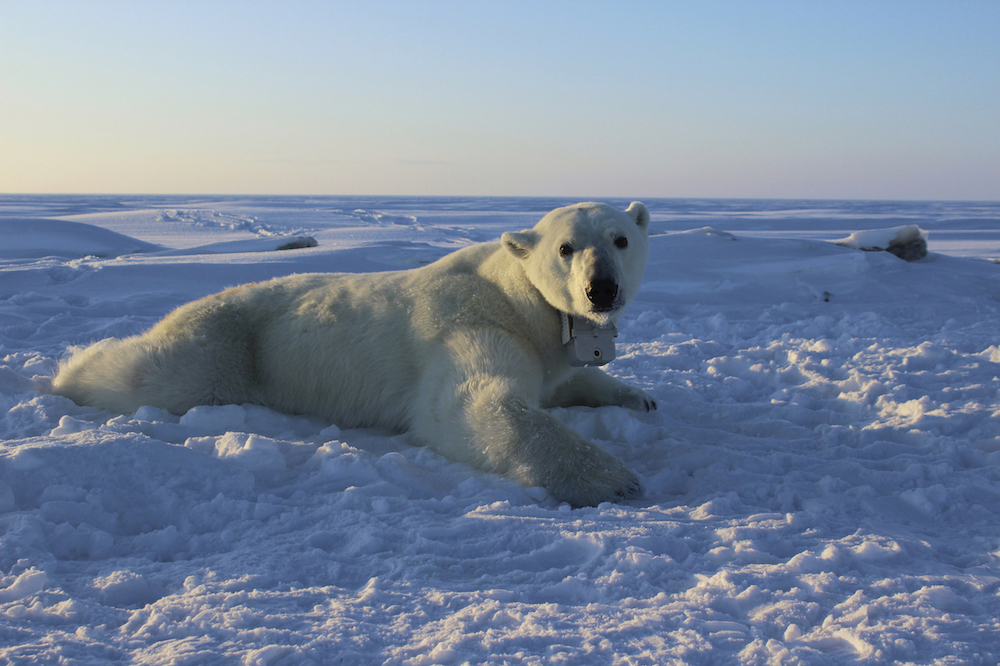近年、アラスカ先住民の小さな村が観光ブームに沸いている。北極海の海氷が減少する中で、ホッキョクグマたちが陸地で過ごす時間が増えているためだ。
現地メディア「Alaska’s Energy Desk(アラスカズ・エネルギーデスク)」が9月5日に報じたところによると、野生のホッキョクグマをひと目見ようと、2,000人以上のビジターが昨年、アラスカ州北部ボーフォート海に面したカクトビック村を訪れた。
この極北の村は、ボーフォート海岸に浮かぶバーター島の北岸に位置している。この地では今、急激に進む地球温暖化によってホッキョクグマの主要な生息地である海氷の動きが加速している。氷が大陸棚を離れて水深の深い海域の方に後退を続ける中、より多くのクマたちが餌を求めて陸地に残るようになってきているのだ。
北極圏国立野生動物保護区のジェニファー・リード氏によると、2011年以前には、村を訪れる旅行者は年間50人以下に過ぎなかった。
「ところが今では、世界各地から毎年ものすごい数の観光客が押し寄せています」。

Photo by Shutterstock
ホッキョクグマは、昔からカクトビック村付近の海氷の上で普通に目撃されていた。ところが村人たちは、1990年代半ばに、ある変化に気付いた。以前よりも、陸地にとどまるクマの数が増えていたのだ。また研究者たちも、氷上ではなく陸地の雪の中に巣穴を作る雌のホッキョクグマの増加に注目し始めた。
リード氏によると、2000年代の初めに、アメリカ合衆国魚類野生生物局に所属する生物学者によって、この地におけるホッキョクグマの生息数増加に関するヒアリング調査が始まった。世界的にも、その10年前に比べて、ホッキョククマの窮状に対する関心が高まりつつあった。こうして、過去よりも多くの観光客がカクトビックに足を向け始めたのである。
ほとんどの観光客は、海氷が陸地から最も遠ざかり、クマたちが陸の方に移動してくる秋の時期を選んでやってくる。クマたちの一部は、再び海が凍結し始める10月、11月まで、カクトビック村の付近に定着する。

Photo by Andy Brunner on Unsplash
また秋は、カクトビックの住民が毎年3頭のホッキョククジラを殺す時期でもある。野生動物観察ツアーを主催するイヌピアック族の住人で、狩りを生業とするブルース・イングランガサク氏によると、村の住民たちは当初、果たして観光客たちが捕鯨に対してどのような反応を見せるのか、あまり確信が持てなかったという。
「村の者はみな、反捕鯨活動家たちが、この地で行われている生業としての捕鯨も止めさせようとするのではないかと、そのことを恐れていたのです」とイングランガサク氏は語った。「しかしながら、その恐れは現実にはなりませんでした」。
そのイングランガサク氏は、2003年か2004年頃から『ホッキョクグマ・ツアー』を始めたそうだ。
ツアー参加者は、ほとんどが中国とヨーロッパからの観光客で、そこにさらにアメリカ本土48州からやってきた観光客も加わる。彼らはアンカレッジとフェアバンクスからチャーター機でカクトビック村に到着する。
イングランガサク氏によると、観光客の多くは、2つの小さなホテルのあるこの村に数日間滞在するという。
—
JUNEAU, Alaska (AP)
—
Information from: KTOO-FM
A tiny Alaska Native village has experienced a boom in tourism in recent years as polar bears spend more time on land than on diminishing Arctic sea ice.
More than 2,000 people visited the northern Alaska village of Kaktovik on the Beaufort Sea last year to see polar bears in the wild, Alaska’s Energy Desk reported Monday.
The far north community is located on north shore of Barter Island on the Beaufort Sea coast in an area where rapid global warming has sped up the movement of sea ice, the primary habitat of polar bears. As ice has receded to deep water beyond the continental shelf, more bears are remaining on land to look for food.
The village had less than 50 visitors annually before 2011, said Jennifer Reed, of the Arctic National Wildlife Refuge.
“Today we’re talking about hundreds and hundreds of visitors, many from around the world each year,” Reed said.
Polar bears have always been a common sight on sea ice near Kaktovik, but residents started noticing a change in the mid-1990s. More bears seemed to stay on land, and researchers began taking note of more female bears making dens in the snow on land instead of on the ice.
U.S. Fish and Wildlife Service biologists began hearing reports of increasing numbers of polar bears in the area in the early 2000s, Reed said. As more attention was given to the plight of polar bears about a decade ago, more tourists stated heading to Kaktovik.
Most tourists visit in the fall, when bears are forced toward land because sea ice is the farthest away from the shore. Some bears become stranded near Kaktovik until the sea freezes again in October or November.
The fall is also when residents of Kaktovik kill three bowhead whales. Bruce Inglangasak, an Inupiaq subsistence hunter who offers wildlife viewing tours, said residents were unsure how tourists would react to whaling.
“The community was scared about, you know, activists that was going to try to get us to shut down the whaling — subsistence whaling,” Inglangasak said. “But that’s not true.”
Inglangasak said he’s been offering polar bear tours since 2003 or 2004.
Most of his clients are from China and Europe, as well as from the Lower 48 U.S. states and arrive in Katovik on charter planes from Anchorage and Fairbanks.
Many tourists stay several days in the village, which has two small hotels, Inglangasak said.
—
JUNEAU, Alaska (AP)
—
Information from: KTOO-FM



